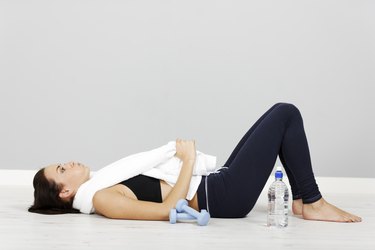
Your muscles make up some of the most integral tissues in your body. Whether you're a 20-year-old body builder, or a 70-year-old retiree, exercise -- particularly resistance exercise -- continues to play an important role in your muscle health. The benefits of working out are due to the direct impact that physical activities have on your muscle tissue, especially during strength training activities.
Resistance
Video of the Day

Muscle changes start with resistance exercise. Whether you're going for a run, doing pushups or lifting barbells, some form of resistance is being placed on the muscle. When this resistance is greater than what your body typically encounters during the day through your regular routine, the process of muscle hypertrophy, or muscle building, is activated.
Video of the Day
Microscopic Tears

When greater than normal resistance is placed on a muscle, small microscopic tears occur in the tissue -- perfectly normal. The size and severity of the tear does depend on exercise intensity. Unfortunately, the greater the tear, the better chance you'll have of developing sore muscles after your exercise, and over-training can result in injuries to the muscles, such as muscle strains or even ruptures. It's important to get the balance of intensity right in order to safely accomplish your training goals.
Healing and Building

The tears in the muscle tissue from exercise disrupt the muscle cell organelles. This disruption activates satellite cells from outside the muscle fibers, which rush to the area of damage. These cells replicate, mature into grown cells and fuse to your muscle fibers. This process forms new muscle protein strands, which increases the strength and visible size of the muscle to better cope with similar physical activity in the future. Other satellite cells are used to heal the already damaged tissue. The healing of the muscle tissue also helps relieve any soreness from the exercise.
Recommendations

In order to see the full benefits of exercise on your muscles, as well as the rest of your body, follow the recommendations set forth by the Centers for Disease Control and Prevention. These recommendations include at least 150 minutes of moderately intense aerobic exercise each week -- such as running, jogging, biking or swimming -- as well as at least two days a week of strength training targeting each of the major muscle groups in the arms, legs, core, shoulders, chest and back.
- University of California - San Diego: Muscle Physiology: Hypertrophy
- University of New Mexico; The Mystery of Skeletal Muscle Hypertrophy; Richard Joshua Hernandez, B.S. and Len Kravitz, Ph.D.
- University of New Mexico; How Do Muscles Grow?; Young sub Kwon, M.S. and Len Kravitz, Ph.D.
- Centers for Disease Control and Prevention: Physical Activity Guidelines